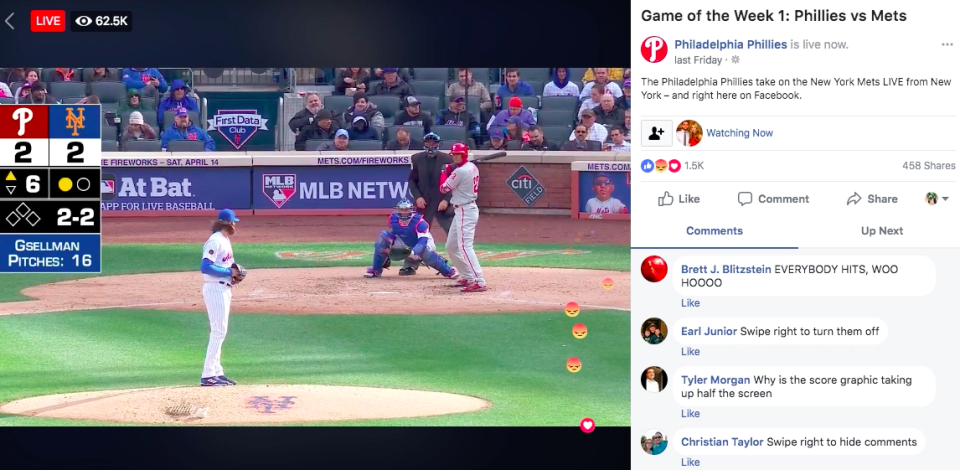Observations from MLB's first Facebook stream
As part of Major League Baseball’s new partnership with Facebook, Wednesday afternoon’s Philadelphia Phillies vs. New York Mets game was streamed exclusively on the social media platform.
The game, a 4-2 Mets win, was the first installment of the 25-game (all weekday afternoon games) agreement, and, after a 97-minute rain delay, things — for the most part — went off without a hitch. The broadcast, with MLB Network’s Scott Braun on play-by-play and former big leaguers Cliff Floyd and John Kruk providing color commentary, was solid, as was the overall quality of the stream itself.
But the change came with some complaints. The arrangement meant the game, which could not be watched without a Facebook account, was not available on local television in either the New York or Philadelphia markets. It was Facebook only, which was undoubtedly foreign to a lot of fans.
And on the heels of Tuesday night’s Phillies-Mets game also only being available via stream in Philadelphia (the two NBC Sports Philadelphia channels had 76ers and Flyers games to air), some folks in the City of Brotherly Love opted to sit Wednesday’s game out.
I, a Philadelphian, was not one of those folks. Here are some of the things I took away from MLB’s first-ever Facebook stream:
The graphic interface was clunky
As good as the video quality was, the rest of the presentation was fairly clunky. Early on in the game, there was an enormous “You Are Watching MLB Live on Facebook Watch” graphic covering up a sizeable portion of the screen. That graphic, coupled with the scoreboard on the left size, did not make for the most visually appealing viewer experience.
Here’s what it looked like on my Macbook:

Thankfully, that top graphic went away after a few innings. It made the experience far more pleasant — though the experience was likely different depending on your device of preference:
Oh no, a comment section
I’m afraid things may not have been as pleasant for other viewers for one reason in particular. When you first opened the stream (which could be located via the MLB, Phillies or Mets pages), it looked a lot like any other Facebook video you have ever clicked on. You saw a comment section on the right side and Facebook also provided the option to “react” to whatever you saw on the screen.
You may be familiar with these options:

So while you watched the game, those emojis would float up onto the screen like with any other Facebook Live video. The floating emojis, coupled with an active comment section, were quite distracting.

Smartly, Facebook gave you the option to get rid of that by clicking on a “turn quiet mode on” button” — but it wasn’t easy to find.

Every time I looked in the comment section there would be somebody asking how to get rid of it. Braun, the play-by-play man, made sure to present that option to viewers a few times during the game, but it could have been much, much easier to locate.
No commercials!
The game had no commercials, and it was a little strange. Once the game ended, Floyd admitted it was different from an announcer’s standpoint to continue with the broadcast between innings. The void was filled with interviews from sideline reporter Alexa Datt, but sometimes the conversation between Braun, Floyd and Kruk continued as the pitcher threw his warm-up tosses. I’m not sure if the same broadcast crew will call next week’s Milwaukee-St. Louis game. If they do, things will likely be a bit smoother on that end moving forward.
Overemphasis on user engagement
Perhaps it was part of an effort to attract a younger audience, but the emphasis placed on user engagement felt very forced. It worked when the announcers would answer questions from commenters during breaks in the action or between innings when Datt included view questions in interviews with Phillies and Mets MLB.com beat writers, but there were other instances that just felt unnecessary.
There were times where Facebook comments — some of which were fan questions — would randomly appear on the screen.


And there were other times where a player’s social media activity would be spliced onto the screen.

Late in the game, there was a “thumbs up or down” segment between innings.

Kruk seemed thrilled to be involved.

In the end, watching the game on Facebook was mostly fine. Most of my complaints were rather minor, but I’d imagine it was much more of an inconvenience for less tech-savvy fans.
With these streams airing strictly on weekday afternoons, it could attract more viewers from the working crowd who may miss the game otherwise. On the whole, I’m not entirely sure what the end goal for this effort could be other than an effort to reach a different (read: younger) audience who could watch from a variety of mediums (smartphones, tablets, laptops, etc).
We’ll see what numbers MLB sends out in terms of viewership from this initial game. Whether the league alters its future broadcast plans by plucking data from these 25 games from a sea of the hundreds and hundreds of games each season remains to be seen.
– – – – – – –
Sam Cooper is a writer for Yahoo Sports. Have a tip? Email him or follow him on Twitter!
More from Yahoo Sports:
• Coach asks NFL prospect: What if I punched you?
• Yankees fans boo Stanton during his 5-strikeout game
• Are Pats and Lamar Jackson a match made in heaven?
• Dan Wetzel: The bromance of Phil and Tiger


